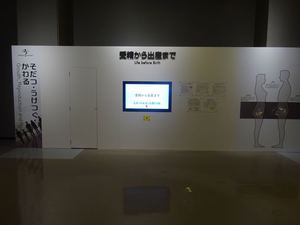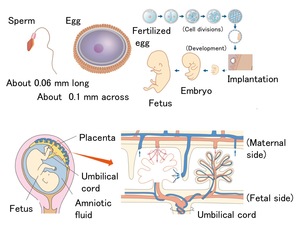Nagoya City Science Museum
TOP > Exhibition Guide > Keyword Search > Starting with "F" > fertilization > Life before Birth
Life before Birth



Purpose of Exhibition
This animation and real-life video presentation explain the process from the meeting between sperm and egg and fertilization to the birth of a human baby.
It invites visitors to feel and reflect on the mysteries and preciousness of life.
The surrounding panels provide information on fertilization and further developments after fertilization.
In 1989, when the Museum’s Life Science Building was opened, the same theme was explored with video images and information panels. The current exhibition is an updated version.
Additional Knowledge
[What are the original cells of a human being?]
In the beginning, there are two different cells.
- Egg (about 0.1 mm in diameter)
Eggs are prepared in the ovaries in the woman’s body. One egg is released into the fallopian tube every 28 days (*) following hormonal changes. This is called ovulation.
(*) The length of cycle varies from one woman to another or depending on the woman’s physical condition.
- Sperm (about 0.06 mm long)
Sperms are produced in the testes in the man’s body. Following stimulation, which gives rise to sperm's swimming ability, semen containing sperms is discharged from the spermatic duct and via the urethra. This process is called ejaculation. About 300 million sperms are discharged in a single ejaculation. Several hundred of these sperms reach the egg after moving through the uterus and the fallopian tube. Only one sperm fuses with the egg, which then becomes a fertilized egg.
[When does a human being begin to be formed?]
The fertilized egg moves, while undergoing cell divisions, and attaches itself to the endometrium, the inner lining of the uterus. This is called implantation. When the fertilized egg starts taking the very first steps of the formation of a human form, it is called an embryo, which later grows as a fetus. This is called development. During this process, organs are formed inside, and the overall shape changes remarkably.
The fertilized egg begins as one cell and grows into several cells through cell divisions. As the number of cells increase, they are put together in groups with different functions, eventually developing into organs and tissues of different sizes and shapes.
Development is a finely organized process, but there are still many questions that are yet to be clearly answered.
[Does the uterus always remain the same?]
After ovulation, the endometrium gradually becomes thicker, stocking up nutrients in preparation for implantation. If no implantation occurs, the nutrients come off and are discharged. This is called menstruation. After this, the inner lining of the uterus thickens again. The body temperature also changes with ovulation and menstruation.
These changes repeat on a cycle of 28 days (*) and are related to the quantities of two female sex hormones released from the ovaries (estrogen and progesterone).
The quantities of the female sex hormones are regulated by two other hormones released from the brain. These two hormones are regulated by another hormone that is produced in a different part of the brain. There is a system of adjustment called “feedback” in which the quantities of these hormones are affected by those of female sex hormones.
(*) The length of cycle varies from one woman to another or depending on the woman’s physical condition.
[How does a baby get air and food while inside the uterus?]
Following implantation, a part of the fertilized egg changes and, together with the uterine tissue, produces placenta. In the placenta, oxygen and nutrients from the mother's blood are sent to the fetus’s, and carbon dioxide and waste from the fetus’s blood to the mothers. Fetal blood and maternal blood are separated by the thin membrane of placenta and are never mixed. The fetus is connected to the placenta via the umbilical cord, which develops from the fetus.
[Why does a baby cry right after birth?]
Inside the uterus, a fetus is floating in the amniotic fluid in the sac that has developed from the fetus. Before birth, the baby’s lungs are shrunk, but immediately after birth, they expand as air enters them, forcing the baby to switch to a new mode of breathing, that is, exchange of oxygen and carbon dioxide in the lungs. The first cry of a newborn baby is the sign of this switch.
The baby’s bloodstream, which used to circulate via the placenta before birth, also changes and begins to circulate between the baby’s heart and lungs.
After the baby’s birth, the placenta comes off the uterus and is expelled. The mother’s expanded uterus gradually resumes its original size.
Courtesy:
Mio Fertility Clinic
Japanese Red Cross Nagoya Daini Hospital
KISHOKAI MEDICAL CORPORATION/ Nagoya Castle Bell Clinic
Article by Tomoko Horiuchi, curator
